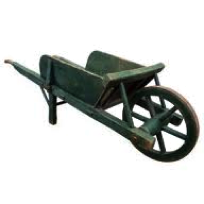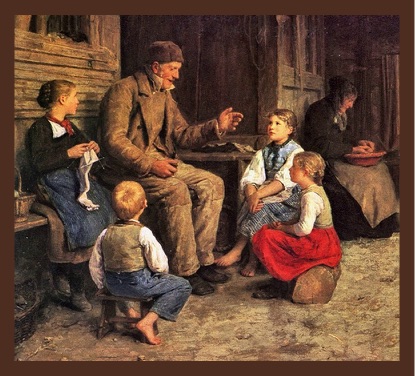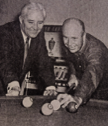
FOLKLORE
is commonly defined as the traditional beliefs, customs, and stories of a community, passed through the generations by word of mouth. Folklore can be a body of popular myth and beliefs relating to a particular place, activity, or group of people
ANECDOTES
are defined as short and amusing or interesting stories about real incidents or persons.
TRIVIA
is defined as "details, considerations, or pieces of information of little importance or value." Of course, if one cares about a subject (such as Darrtown), then, the "trivial" becomes "terrific!"
This page is intended to capture and preserve stories of Darrtown that inform, warm the spirit, provide humor, and, in some cases, extend mysteries. If you have a Darrtown-related story to share, please contact the Webmaster.
UHL - CORNELIUS WHEELBARROW BET
Webmaster note: The"Wheelbarrow" story, at the left, appeared in an undated newspaper clipping from the Hamilton Journal News. A Google search revealed that, in the prize fight that prompted the bet described here, Joe Louis defeated Jack Sharkey on Tuesday, August 18,1936. Consequently, this newspaper account of the “Uhl-Cornelius Wheelbarrow Bet” must have been published between Wednesday, August 19, 1936 and Sunday, August 23, 1936.
"Looks Like A Long, Long Trail for Uhl Wheeling Wheelbarrow
Unlike most “wheelbarrow” bets, the one on which Charles Uhl, of Darrtown , must transport Clayton Cornelius a distance of two-and-a-half miles Sunday morning carries a “rider” that says “without stopping.”
That Uhl must wheel a wheelbarrow that far with winner Cornelius lolling in it, just because he thought Sharkey would take Joe Louis into camp Tuesday night, seems bad enough; but to do it without stopping is more of the same thing, as anyone who has wheeled a barrow with a moving load will testify.
For the enlightenment of Butler County residents not thoroughly familiar with the industrial one-wheeled vehicle, a wheelbarrow is hard to manage, if its contents insist on shifting weight from right to left or back and forth.
As the starting time of Mr. Uhl’s travail has been set at 9 o’clock Sunday morning, as the journey will extend from a Darrtown restaurant to a point an hour’s wheel away, and as long as there will be persons in the crowd along the highway who know both Winner and Wheeler well, it is anticipated that the Winner will take the opportunity to wave his hands in greeting, and that the gambling flair in Mr. Uhl will be sorely tried.
True to the spirit of the transaction, however, Mr. Uhl is reported practicing industriously in the art of rolling his barrow, and has it all painted and greased in readiness for the starting bell."
Webmaster Note: The "Hangman's Hollow" story, at the right, is a reprint of a Hamilton (Ohio) Journal News column, written by Jim Blount. It was found as part of a Hamilton Journal News collection at the Lane Library - Hamilton, Ohio. The story is #61 and dated October 29, 1989.
DARRTOWN'S CONNECTION TO "HANGMAN'S HOLLOW"
Four young men from the Darrtown area -- Taylor Marshall, Ben Scott, Chambers Flenner and Dan Warwick -- went by horseback to the first fair Oct. 2-3, 1851.
After their day at the fair, the foursome, who have been credited with establishing the factual basis for the legend, crossed the covered bridge from Hamilton to Rossville and headed west on the Hamilton, Rossville, Darrtown, Oxford and Fairhaven Turnpike
It was dark as they approached the dip, or hollow, in the road about a mile and half west of Rossville (a town later merged into Hamilton). The Darrtown men encountered a small group of people who had gathered in the roadway. They had been attracted there by the lifeless body of a man hanging from a tree just off the dusty turnpike.
Some believed the man, who had been dead for several days, had committed suicide. They pointed out that he died with his suspenders around his neck, not a rope.
It was several days later before the victim was tentatively identified as a stockman who had left a Hamilton hotel about a week earlier to call on Butler County farmers. He hadn't returned to Hamilton, as expected. Others recalled that the apparent victim also had flashed "quite a roll of money" before leaving town. The bundle of bills was considered large enough to invite robbery.
A robbery or murder along a lonely turnpike was not an unusual crime in the mid-19th century. The 1851 incident beside the Darrtown Pike was not enough to attach the eerie Hangman's Hollow label to the spot. Instead, it was what happened or supposedly happened, after the robbery-murder in October 1851.
Several times in succeeding years, travelers along the road between Rossville and Darrtown told of seeing a mysterious image in the hollow. The aberration was believed to be the ghost of the hanged stock dealer.
Others passing the spot didn't see a ghost. But they heard a strange voice or voices, possibly coming from one or more unseen ghosts. In most instances, the voice warned riders to beware of danger lurking there. According to the 1910 report, for several generations, travelers through the spooky woods spurred their horses for extra speed to avoid an encounter with a ghost or mysterious voices."

THERE ARE FIVE DIRECT CONNECTIONS:
#1 In the 1880's, Huston D. Kyger trained trotting horses on his Scott Road farm, just east of Darrtown, and he competed in professional trotting races throughout the eastern United States. H.D. Kyger's most successful trotter was Kit Curry, a horse that Mr. Kyger discovered pulling a huckster's wagon in Eaton, Ohio. Mr. Kyger's trotting horse legacy is detailed at the Kyger Family page.
#2 In 1920, the Darrtown baseball team and the Hamilton Hoovens engaged in a three-game series, on the Darrtown field (south of the village, next to the old railroad levee). Over 9,000 fans attended the three games, which featured three professional pitchers: Horace "Hod" Eller of the Cincinnati Reds pitched for the Darrtown boys, while Charlie Root of the Chicago Cubs and Carl Wielman of the St. Louis Browns pitched for the Hoovens (this series is detailed at History Page 6).
#3 Darrtown native and graduate of Darrtown High School, Walter "Smokey" Alston, managed the Brooklyn and Los Angeles Dodgers for 23 years (1954-1976)
#4 Cliff Alexander, Darrtown native and graduate of Darrtown High School, was a scout for the Brooklyn Dodgers and the Cincinnati Reds.
#5 Darrtown native, Kirk Mee III, was an assistant coach with the Washington Redskins professional football team for 25 years, as he assisted George Allen, Jack Pardee, Joe Gibbs, and Norv Turner.
THERE ARE TWO LESS-THAN DIRECT CONNECTIONS:
Granted, these connections resemble the game known as "Six Degrees of Separation." But, they are real and they do exist!
> Luther and Opal McVicker's third daughter, Mary Lou McVicker, married Larry Simison; Larry and Mary Lou Simison's second daughter, Nancy Simison married Ed Wolterman; Ed Wolterman's sister, Alice, married Joe Torre, who managed the Los Angeles Dodgers for three years (2008-2010). So, there you have it; another Darrtown connection to professional sports - McVicker to Torre!
> Joe Pater, who lived on Schollenbarger Road during 1950's and 1960's is a cousin of Hamilton (Ohio) native, Jim Tracey, whose professional managing career includes 2001-05 with the Los Angeles Dodgers; 2006-07 with the Pittsburgh Pirates, and 2008 to present (2012) with the Colorado Rockies. Ergo, another Darrtown connection to professional sports - Pater to Tracey!
DARRTOWN'S CONNECTION TO PROFESSIONAL SPORTS


Webmaster Note: If you know of other connections between Darrtown-related people and professional sports, please contact the Darrtown webmaster.
In the field of land law, an unincorporated community is a populated place that is not within any incorporated municipality (city), but is within the jurisdiction of a county or other political subdivision.
There are many unincorporated, communities in the United States. To demonstrate the abundance of unincorporated communities in the United States, consider that , according to Wikipedia (February 2012), Ohio, alone, has 465 unincorporated communities. With 88 counties in Ohio, that calculates, on average, to 5.28 unincorporated communities per county.
UNINCORPORATED COMMUNITIES

POP QUIZ: HOW MANY of the 465 unincorporated communities in Ohio have names that START WITH THE LETTER "D"?
MORE ABOUT UNINCORPORATED COMMUNITIES
The 2012 Wikipedia source (cited above) also reports that:
The most populated U.S. state, California, has 2,173 unincorporated communities
The least populated U.S. state, Wyoming, has 55 unincorporated communities.
Findings for the year 2008, as reported in Wikipedia's "Demographics of the United States," include:
The U.S. is a very urbanized population, with 82% residing in cities and suburbs (the worldwide urban rate is 50.5%).
The United States has a total resident population of 313,087,000, making it the third most populous country in the world.
This leaves vast expanses of the country nearly uninhabited.
California and Texas are the most populous states, as the mean center of United States population has consistently shifted westward and southward. New York City is the most populous city in the United States. Some American states have no unincorporated land areas; these include Massachusetts, New Jersey, Connecticut, and Rhode Island.
Given the information above and factoring in a total of 50 U. S. states, it seems reasonable to infer that there are tens of thousands of unincorporated communities throughout America. And, yet, using the 82% figure that appears above, the total population of all those U. S. small towns, villages, and hamlets calculates to only 18% of all Americans.

IT REALLY IS A SMALL WORLD
This section could be titled "It has happened to me; has it happened to you?"
On numerous occasions, individuals have commented that, at unexpected times and in unexpected places or circumstances, they discovered people with connections to Darrtown.
Here are some examples of this phenomena:

When a Bicentennial committee member spoke with a representative of a the Oxford Press newspaper about publicizing the event, the newspaper rep revealed that she married a man who grew up in Darrtown.
When a different Bicentennial committee member contacted a Hamilton, Ohio printing company representative about the production of Bicentennial flyers, it was discovered that the printing company rep lived in Darrtown several years ago.
A third member of the Bicentennial committee reported that, in recent years, he has regularly met with a group of men for early morning coffee. After all the years of visiting with each other, one of the men in the coffee group, who is a Hamilton-area artist, revealed that he had studied under the tutelage of an art instructor from Darrtown. That led to the discovery that the Hamilton-area artist's mentor had been (now deceased) Darrtown native and professional commercial artist, Virgil Alston.
"Hanged man's ghost started legend: Legend of Hangman's Hollow began in 1851
Halloween is an appropriate time to recall a ghost story with a factual base which is part of Butler County folklore. It is the legend of Hangman's Hollow, complete with scary reports of ghost sightings and warnings from unseen persons.
Hangman's Hollow is west of the new Hamilton Meadows Shopping Center in a wooded area northwest of the intersection of Gardner Road, Hamilton-Richmond Road (Ohio 177) and Old Oxford Road (Ohio 130).
There are several versions of the legend, which is understandable, because the story survived for many years, and from generation to generation, by word of mouth. Some verbal variations even differ on the exact site of Hangman's Hollow.
What appears to be the first printed account — complete with the names of key participants, location and the date of the event which started the legend — was published Oct. 13, 1910, in the Hamilton Telegraph.
The report said the story was associated with the first Butler County Fair in 1851. That year the fair was held on a site along High Street east of Sixth Street. (The fair was moved in 1856 to its present location, the Butler County Fairgrounds.)

Click these links for quick access to the following stories:


To see the answer, hover your cursor over the "Extra Info" icon at the right.
VILLAGE POOL SHARK - WALTER "SMOKEY" ALSTON
Luther McVicker ran the village gas station for over six decades and was a good friend of Walter's. In the recollections of Luther and his wife, Opal, Luther shared the following memory:

Truth be told, "Smokey" was never a "shark," as it was against his nature to deceive anyone about his pool-playing ability.
as "Smokey" was known to have played with players of national fame.
"Another time, I went to Dayton with Smokey Alston to watch him play pool with "Minnesota Fats." Smokey was quite a pool player. He had a pool table on the first floor of his house."
FYI:
"Minnesota Fats" was the nickname adopted by Rudolf Walderone, who was a renown pool hustler during the middle of the 20th century.

On page 155 of his autobiography, Walter explains how he met pool champion Willie Mosconi and describes the time that Mosconi came to the Alston house in Darrtown for dinner. Click the "Smokey vs. Willie" link below.
FYI:
The photo at the right appears on page 148 of Alston's autobiography.
From 1941 to 1957, Willie Mosconi won the World Straight Pool championship 19 times! To learn more, see: Willie Mosconi
The title of Alston's autobiography is taken from his major-league managing career, which is likely to never be duplicated: 23 consectutive years ... with the same club ... all on one-year contracts.
On page 155 of his autobiography, Smokey told of Willie Mosconi's visit to the Alston home on Darrtown's Apple Street. Click the "Extra info" icon to see Smokey's description of his game with the "Great Mosconi!"

Walderone adopted his nickname from The Hustler, a 1961 movie that featured Jackie Gleason and Paul Newman. Click the following link to learn more about the man known as "Minnesota Fats." See: Rudolf Walderone
"Minnesota Fats"
